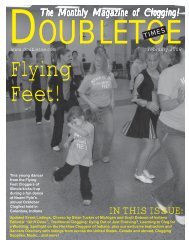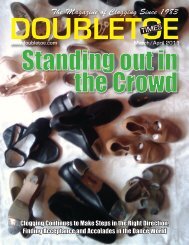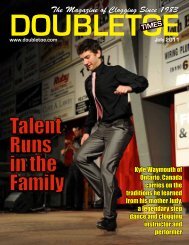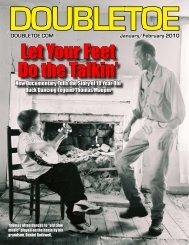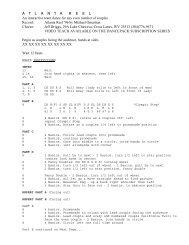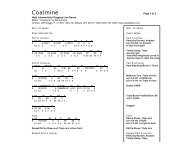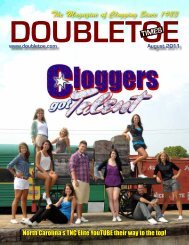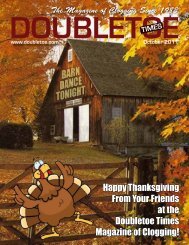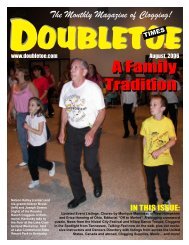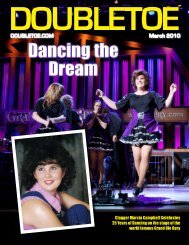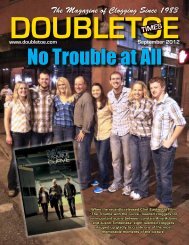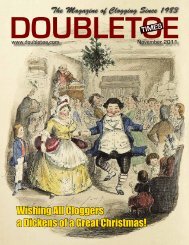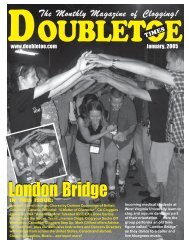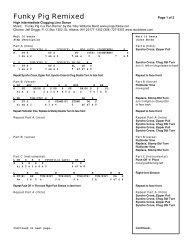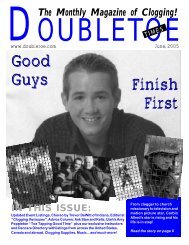Apr May 2010 - Double Toe Times
Apr May 2010 - Double Toe Times
Apr May 2010 - Double Toe Times
You also want an ePaper? Increase the reach of your titles
YUMPU automatically turns print PDFs into web optimized ePapers that Google loves.
Calling/Running A Public Dance<br />
By: Steve Smith<br />
Reprinted from the Canadian Dancers News<br />
I truly feel blessed. Without a man named Richard Jett I<br />
would have no idea about how to run a public dance. But<br />
we’re blessed in Central/Eastern Kentucky because we<br />
have access to a place called Hoedown Island with the<br />
legacy of a wonderful caller named Richard Jett. Richard<br />
Jett was calling dances when I was in my diapers and<br />
I’ve met no one yet who could generate as much fun for<br />
cloggers, western square dancers, and non-cloggers<br />
as well as Richard Jett.<br />
In no way comparing myself to him, I will<br />
share with you some of what I learned by<br />
being with, watching, and dancing with<br />
Ol’ Richard. Everything that I know<br />
about calling a public dance comes from<br />
Richard. Here are some of the qualities<br />
that separated Richard’s dances from<br />
those of others. Let’s look at these<br />
factors in turn.<br />
Richard’s dances were fun for everyone<br />
– regardless of skill level or age.<br />
Most importantly, the dance must be<br />
FUN FOR EVERYONE, even for those who<br />
don’t know how to dance. It is important<br />
not only to play line dances for cloggers who<br />
have had formal instruction, but to also “walk<br />
the newcomers through” some big set figures and<br />
other fun dances with the emphasis on patterns instead<br />
of footwork. Of course the cloggers do their fancy footwork<br />
but the newcomers feel very much accepted.<br />
Richard played a variety of dances for everyone<br />
regardless of skill level or age.<br />
By offering a variety of dances, the caller insures that<br />
everyone there will find something that they like to do. By<br />
playing a variety of music, the caller insures that everyone<br />
there will HEAR some of their favorite kinds of music.<br />
Richard called a couple of 4- couple squares (that can be<br />
clogged to), some dances for children (hokey-pokey, bunny<br />
hop, birdie song), have 3-4 exhibitions, played some slow<br />
dances and waltzes, a couple of polkas, some freestyling, a<br />
Virginia Reel, and maybe a Western Tip.<br />
Richard was skilled at calling, joke-telling, and human<br />
relations.<br />
The caller must be a skilled “caller”. To get up in front of<br />
a group of people and just put one record on after another<br />
is not to “call a dance”. Hard work and education are<br />
needed so that big sets, reels, and squares can be well<br />
called. You need not be able to sing to call (I’m certainly a<br />
good example of that!). You do need to study big set calls,<br />
patterns, patter, and practice, practice, practice.<br />
A caller must work to endear him/herself to the<br />
participants. Laughing at one self when a mistake is made,<br />
telling a joke or funny story, sharing personal tidbits are a<br />
great way to loosen up yourself as well as the audience.<br />
Humor is a great boost to any dance and it is generally true<br />
that the atmosphere of the dance will reflect the callers’<br />
demeanor. Therefore, if you want your dancers to be loose<br />
and relaxed, you the caller must be also.<br />
Richard was in charge – No drinking allowed. Provides<br />
good, clean fun.<br />
The caller must be in charge of the dance. It is up to him/<br />
her to set the social limits for the dance. The caller must be<br />
policeman, watch guard, and protector. This might take the<br />
form of asking an intoxicated person to leave the dance.<br />
Or it might consist of setting an age limit on a dance with<br />
adults that is so lively that younger children might get hurt<br />
(Nine-pin reel).<br />
Richard helped all feel like part of a large family. He<br />
praised but never criticized.<br />
A caller must encourage the dancers and spur<br />
them on to give even more effort in their dance.<br />
Richard did this by saying something like,<br />
“Aw friends you’re looking food tonight”!<br />
We all like to be praised and want to feel<br />
good about ourselves. A good caller can<br />
make that happen. There is no place for<br />
any type of criticism. People are there<br />
to have a good time. The dance should<br />
be organized so that many are included<br />
in the opening so that enthusiasm can<br />
be generated. By doing a big set opener<br />
people can interact with each other and<br />
generate enthusiasm.<br />
Richard was prepared and organized so<br />
that the dance flowed smoothly.<br />
A caller must let people know what they<br />
can expect from the dance. Encouragement and<br />
suggestions what all will have fun and that dances will be<br />
played that all can participate in helps to shape positive<br />
expectations for the participants and reduce anxiety.<br />
Lastly, the caller must be organized so that the dance<br />
isn’t totally called “off the cuff”. On the other hand, there<br />
must be flexibility in the caller for alterations in plans as<br />
the dance necessitates. Most callers will have a list or<br />
itinerary to help them organize the dance and the flow<br />
of the dance. I use a sheet what helps me to alternate<br />
line dances, freestlying, exhibitions, big sets, squares,<br />
children’s dances, etc. That way I help to insure that I don’t<br />
get stuck on line dances or forget to play a slow waltz or do<br />
something for the children.<br />
While I have tried to share some of my observations of<br />
qualities that Richard appeared to bring to a public dance,<br />
I can in no way capture the man. His demeanor and<br />
persona supersede any written description of him and his<br />
gift that he shared with others.<br />
Thanks again, Richard.<br />
Editor’s note: The clogging world lost a pioneer, a true<br />
friend and a legend in the passing of Richard Jett in<br />
August of 2006. Steve Smith has now announced his<br />
retirement from the clogging world. Steve, for all you have<br />
contributed to the art of clogging, the choreography and<br />
teaching standards that you leave as a legacy, we thank<br />
you and wish you all the best my friend.<br />
14 www.doubletoe.com The <strong>Double</strong>toe <strong>Times</strong> Magazine of Clogging



